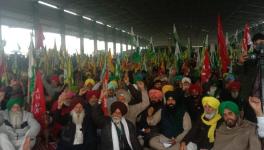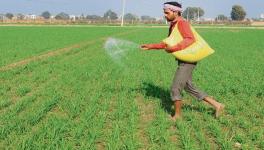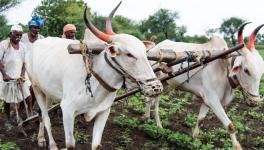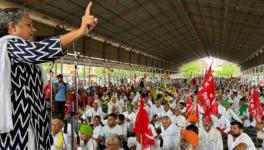Bihar: Distressed Farmers Say They Have no Faith in Centre’s Claims on Doubling Income
Patna: Rajendar Mandal and Bijendar Yadav, two marginal farmers, say they have no faith in the Bharatiya Janata Party-led National Democratic Alliance government at Centre which is claiming to double their income by 2022 as per its Union Budget proposals tabled in Parliament on Monday.
Both the marginal farmers suffered heavy losses last year after being forced to resort to distress sales of their maize crop.
Mandal and Yadav, residents of a village under Murliganj in Madhepura district, a part of the flood-prone Koshi region, are among thousands of maize-growing farmers, who hardly recover their cost of production (seeds, fertilisers, insecticide, labour charge), so the question of “doubling” income does not arise.
“We heard that the Central government in the Budget claimed to double farmers’ income by next year. This is nothing but fooling farmers who have been struggling for survival”, said Mandal, adding that farmers are not getting the right price for their produce after months of hard labour.
“It is useless and far from truth to believe that farmers' income will be doubled. This is like the promises (made by Prime Minister Narendra Modi in 2014) of Rs 15 lakh in our bank accounts after the return of black money from abroad or achhe din (good days) and creation of two crore jobs annually. If farmers get decent returns for their produce, we will be a happy lot. Doubling income is only a dream on paper”, he said.
Mandal blamed lack of government support to farmers as the reason for their hardly getting minimum support price (MSP) for maize, forcing them to resort to distress sales.
Narrating the painful ordeal, Yadav said thousands of marginal and small farmers had been forced to migrate from the fertile belt of Koshi as agriculture has become loss- making.
“Farmers are in distress due to the low income from agriculture and are migrating to work as workers in factories in different states. Why will farmers migrate if they are happy and their income is good? The government in Delhi has no understanding of the ground reality and is working on fake data about actual income of farmers”, said Yadav.
In the 2020 summer, maize-growing farmers sold their corn to local traders at between Rs 900–1,000 per quintal, against Rs 1,800- 2,000/quintal in 2019.The Centre has fixed an MSP of Rs 1,760 per quintal for maize.
Ironically, maize is the lifeline for farmers in the region, but the NDA state government, led by Nitish Kumar, has refused to provide MSP by procuring maize. Koshi, along with Seemanchal, in Bihar is known as a hub of maize cultivation.
According to officials from the state agriculture department, nearly 65% of the total maize from Bihar is grown in the Seemanchal and Koshi regions alone. Maize is mainly grown in the four Seemanchal districts of Purnea, Kishanganj, Araria, Katihar and in the neighbouring districts of Madhepura, Saharsa, Supaul and Khagaria, areas that form the Koshi region.
As per government data, maize is grown in about 1,40,000 hectares in the Seemanchal region and in over a90,000 hectares in the Koshi region.
More than 17 lakh tonnes of maize is grown annually in Seemanchal and Koshi. Of this, more than 14 lakh tonnes is purchased by traders and multinational companies and sent outside the area, while around 3 lakh tonnes is consumed locally, according to data till 2019.
According to the officials, Bihar has high maize productivity of 3,904 kg/ha, more than the national average of 2,889kg/ha. The state has witnessed a sizable growth in maize production over the past decade.
Bihar is India’s third largest producer of maize. The state produced 1.36 million tonnes of the crop in 2005-06. This increased to 3.85 million tonnes in 2016-17, as the high-yielding maize of Rabi season has been replacing the winter crops of wheat and paddy in the state.
The situation is not too different in the case of paddy and wheat-growing farmers near Patna.
Balmiki Sharma, a farmer from Paliganj block in Patna, said: “We have no faith in the (Central) government’s claim on doubling farmers’ income. It is impossible by 2022. How can the government double income without a proper plan on the ground.”
Sharma, who is the secretary of the Paliganj Bitarni Krishak Samiti – a farmers’ organisation – said: “Kisan ka double income ek khayali pulao hai.” (Doubling farmer income is like building castles in the air) .He said there was nothing for farmers in the Budget, adding that it was “anti-farmer”.
Sharma said farmers would be happy if the government ensured MSP for their produce.
“Farmers are not getting genuine rates for their produce and the government is talking about double income. This is a joke. Most of the farmers are being forced to go for distress sales after every harvest, be it Kharif or Rabi.”
Incidentally, Bihar recorded a lower volume of wheat procurement by the government at MSP last year. As per official figures, only 0.05 lakh tonnes (LT) of wheat were procured in Bihar in the Rabi marketing season of 2020-21, against the revised target of 7 LT. In 2019-20, state agencies procured 0.03 LT of wheat.
According to government data, nearly two-third of Bihar’s total population of 12 crore is dependent on agriculture for their livelihood. Most of them are small and marginal farmers. Moreover, nearly two-third of all agricultural activities in the state are dependent on rainfall.
Agriculture is the backbone of Bihar’s economy, employing 81% of the workforce and generating nearly 42% of the state’s gross domestic product, according to state government’s figures.
Get the latest reports & analysis with people's perspective on Protests, movements & deep analytical videos, discussions of the current affairs in your Telegram app. Subscribe to NewsClick's Telegram channel & get Real-Time updates on stories, as they get published on our website.
























